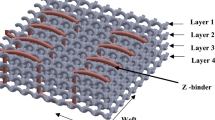Abstract
Prototype continuous, unidirectional, fiber-reinforced composite archwires were manufactured into round and rectangular profiles utilizing a photo-pultrusion process. Both 0.022 inch (0.56 mm) diameter and 0.021 × 0.028 inch (0.53 × 0.71 mm) rectangular composites were formed utilizing commercially available S2-glass® reinforcement within a polymeric matrix. Reinforcement was varied according to the number, denier and twists per inch (TPI) of four S2-glass® yarns to volume levels of 32–74% for round and 41–61% for rectangular profiles. Cross-sectional geometry was evaluated via light microscopy to determine loading characteristics; whereas two flexural properties (the elastic moduli and flexural strengths) were determined by 3-point bending tests. Morphological evaluation of samples revealed that as the TPI increased from 1 to 8, the yarns were more separated from one another and distributed more peripherally within a profile. For round and rectangular profiles utilizing 1 TPI fibers, moduli increased with fiber content approaching theoretical values. For round profiles utilizing 1 TPI and 4 TPI fibers, flexural strengths increased until the loading geometry was optimized. In contrast, the flexural strengths of composites that were pultruded with 8 TPI fibers were not improved at any loading level. Doubling the denier of the yarn, without altering the loading, increased both the moduli and flexural strengths in rectangular samples; whereas, the increases observed in round samples were not statistically significant. At optimal loading the maximum mean moduli and strengths equaled 53.6 ± 2.0 and 1.36 ± 0.17 (GPa) for round wire and equaled 45.7 ± 0.8 and 1.40 ± 0.05 (GPa) for rectangular wires, respectively. These moduli were midway between that of martensitic NiTi (33.4 GPa) and beta-titanium (72.4 GPa), and produced about one-quarter the force of a stainless steel wire per unit of activation. Values of strengths placed this composite material in the range of published values for beta-titanium wires (1.3–1.5 GPa). © 2000 Kluwer Academic Publishers
Similar content being viewed by others
References
M. DAVIDSON, Adv. Mater. & Prod. 146 (1994) 70.
T. J. REINHART and L. L. CLEMENTS, in “Engineered Materials Handbook, Vol. 1; Composites” (ASM International 1987) p. 28.
A. J. GOLDBERG and C. J. BURSTONE, Dent. Mater. 8 (1992) 197.
A. C. KARMAKER, A. T. DIBENEDETTO and A. J. GOLDBERG, J. Biomater. Appl. 11 (1997) 318.
J. JANCAR, A. T. DIBENEDETTO and A. J. GOLDBERG, J. Mater. Sci.: Mater. Med. 4 (1993) 562.
J. JANCAR, A. T. DIBENEDETTO, Y. HADZIINIKOLAU, A. J. GOLDBERG and A. DIANSELMO, ibid. 5 (1994) 214.
J. JANCAR and A. T. DIBENEDETTO, ibid. 4 (1993) 555.
R. P. KUSY and K. C. KENNEDY, U.S. Patent No. 5 869 178 (1999).
K. C. KENNEDY and R. P. KUSY, J. Vinyl Additive Technol. 1 (1995) 182.
V. NARAYANAN and A. B. SCRANTON, Trends in Polymer Sci. 5 (1997) 415.
K. C. KENNEDY, T. CHEN and R. P. KUSY, J. Mater. Sci.: Mater. Med. 9 (1998) 243.
T. CHEN and R. P. KUSY Idem., ibid. 9 (1998) 651.
T. CHEN and R. P. KUSY Idem. in “Advanced Composites X. Proceedings of the 10th Annual ASM/ESD Advanced Composites Conference & Exposition”, Dearborn, MI, Nov. 7-10, 1994 (ASM International, Materials Park, OH, 1994) p. 191.
K. C. KENNEDY and R. P. KUSY, J. Biomed. Mater. Res. 41 (1998) 549.
C. J. BURSTONE, Am. J. Orthod. 80 (1981) 1.
R. P. KUSY, The Angle Orthodontist 67 (1997) 197.
R. A. FLINN and P. K. TROJAN, “Engineering Materials and Their Applications”, 3rd edn (Houghton Mifflin Company, Boston, 1986) p. 447.
O. W. ESHBACH and M. SOUDERS, “Handbook of Engineering Fundamentals” 3rd edn (John Wiley and Sons, New York, NY, 1975) pp. 513 and 518.
R. P. KUSY and L. E. STEVENS, The Angle Orthodontist 57 (1987) 18.
J. F. SHACKELFORD, “Introduction to Materials Science for Engineers” 2nd edn (Macmillan Publishing Co., New York, NY, 1988) p. 473.
R. P. KUSY and A. M. STUSH, Dent. Mater. 3 (1987) 207.
A. J. GOLDBERG, C. J. BURSTONE, I. HADJINIKOLAOU and J. JANCAR, J. Biomed. Mater. Res. 28 (1994) 167.
R. P. KUSY, G. J. DILLEY and J. Q. WHITLEY, Clinical Mater. 3 (1988) 41.
Elgiloy1 and Tru-Chrome1 Stainless Steel Orthodontic Treatment Wires, promotional literature of Rocky Mountain Orthodontics (1977) p. 5.
Author information
Authors and Affiliations
Rights and permissions
About this article
Cite this article
Fallis, D.W., Kusy, R.P. Variation in flexural properties of photo-pultruded composite archwires: analyses of round and rectangular profiles. Journal of Materials Science: Materials in Medicine 11, 683–693 (2000). https://doi.org/10.1023/A:1008903224180
Issue Date:
DOI: https://doi.org/10.1023/A:1008903224180



